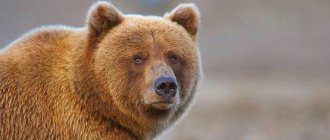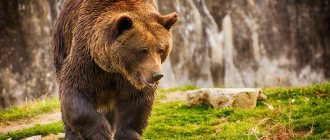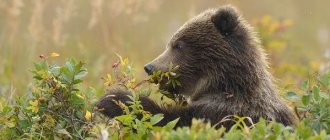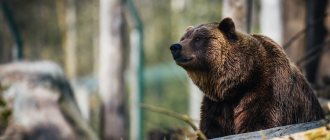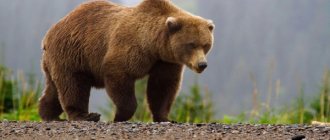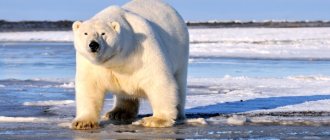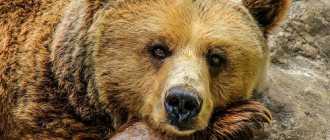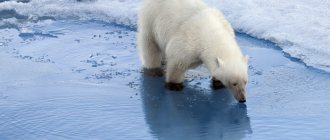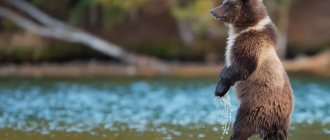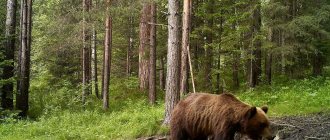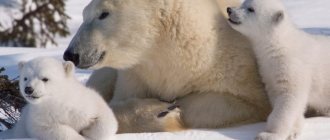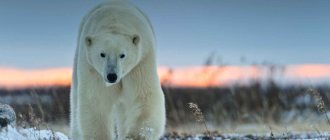There are many forests in the world, and they are home to a huge number of different animals. One of them is a bear - a very strong, cunning and, despite its apparent clumsiness, a fast and agile animal. Rarely will a person come out of a confrontation with him alive and well, and therefore meeting this animal one-on-one is strongly not recommended.
Although there are small and not very dangerous individuals in the bear family, they are also capable of causing significant damage to others. And it’s best to admire the largest bears in the world in zoos and national nature reserves. This article contains information about hero bears and their position in the ranking of “the most special”.
Gubach (weight 54 – 140 kg)
The bear has an original appearance and has a suitable nickname - sponger. It is otherwise called “sloth bear” for its resemblance to this sedentary animal. It is similar to a sloth in the structure and shape of the head, snout and eyes. The bear's lips are bare, extended into a proboscis. This is the reason for its name. Gubach closes the top ten largest bears in the world.
Its length is 1 m 80 cm, the weight of the smallest individuals is 54 kg, the largest - 140 kg. It has sickle-shaped claws, with the help of which it easily climbs trees and destroys termite mounds and anthills. After all, the sloth fish loves these colonial insects as food. But in general he is an omnivore - he loves honey, fruits, and will not refuse carrion.
The sloth fish lives in the forests of the Indian Peninsula (India, Nepal, Pakistan). Able to live up to forty years. But now it is endangered and is listed in the International Red Book.
What abilities does a bear have?
The predatory mammal can move at a speed similar to the running of a racehorse, that is, about 60 km/h. The incredible dexterity with which it moves through the trees is the envy of any athlete. The bear itself is capable of climbing to a height of 30 meters without any extra effort (for comparison, this is a 9-story building). Only a professional climber or an athlete equipped with special equipment will be able to climb such a peak. In addition to mountaineering, the bear also wins in athletics. Undoubtedly, a person loses to the owner of the forest by almost all criteria, not counting the intellectual one. By the way, we will touch on the issue of intelligence and intelligence later and find out which of the bears is truly ready to take their place as the largest, strongest and smartest.
Himalayan bear (weight 120 – 140 kg)
The Himalayan bear is also called the white-breasted or moon bear. It received this name because of its color. He himself is black, and on his chest there is a white spot in the shape of a crescent. This mammal ranks 9th in the ranking of the largest bears in the world.
Weighs about 140 kg, its height is 1 m 70 cm. Its food is mainly herbaceous plants, shoots of bushes, berries, acorns, and nuts. This food makes up the vast majority of his diet (about 90%). But if a frog, an anthill, or a dead animal comes across his way, he will not pass by. Quite aggressive, not afraid of humans.
Habitat: forests in the Himalayan mountains, Pakistani and Iranian forests, Korea and Japan. The Himalayan bear is found in the Far East of Russia (southern Khabarovsk Territory and Primorye). Representative of an endangered species in the Red Book.
The largest species recorded in Kamchatka
The height of a brown bear reaches two meters. The largest species live in Kamchatka, the Far East and Alaska. Standing, their height is about three meters. How much does a brown bear weigh? It depends on some factors:
- from the floor;
- from age;
- from the habitat.
As a rule, the largest individuals are males. Females are slightly smaller than them. They can weigh from 90 kg to 210 kg. The weight of an adult brown bear, a male, ranges from 140 kg to 400 kg. There are exceptions. For example, some individuals can reach 600 kg. A real giant was found on one island; you can hardly guess how much it weighed. One has only to marvel at its greatness; it reached a mass of 1,134 kg and was about 4 meters in height.
In Russia, such large animals are not found. The dimensions of these animals are slightly smaller. For example, the brown grizzly bear subspecies weighs about 500 kg; as an exception, it can reach 700 kg. Average individuals weigh about 100 kg.
White Northerner
You can’t immediately determine how much a polar bear weighs. In appearance, it looks smaller than its brown and black relatives. Mostly white animals live in the snowy northern latitudes of our Planet. This species is widespread in the Arctic. Females reach a body weight of 300 kg, but males are almost twice as large. Their weight ranges from 350 kg to 450 kg. So white relatives are no less than their heat-loving brothers. There are also white individuals that can weigh half a ton. Therefore, polar bears, no matter how much they weigh, are not less, but even more than brown ones. Features of white animals:
- have a length of up to 3 meters;
- covering coat is off-white;
- the paw span is more than 3 meters.
A tall person would be just over the shoulder of a polar bear. When he stands on his hind legs, he becomes very dangerous. Despite the fact that these northern inhabitants look white, their skin is black. Their white fur is transparent to the sun.
The color of the white inhabitants allows them to camouflage well in the snow. This beast, with its weight, height and paw span, is a serious fighter with whom it is better not to joke.
Spectacled bear (weight 70 – 140 kg)
A unique specimen among the family of the largest bears in the world is the spectacled bear. Its habitat is South America. The beast prefers the forested mountainous terrain of the Andes. This is the only species in South America. Weight varies from 70 kg to 140 kg, length can reach 1 m 80 cm. It has a short muzzle compared to other bears. The eyes are surrounded by white and yellow circles, reminiscent of glasses.
He, like other big bears, builds a den for himself, but does not hibernate. It goes hunting at night or at dusk. It eats various roots, grass, shoots, and fruits. Sometimes kills deer, considered a loner. The lifespan is short - within 20 years. Listed in the Red Book as an endangered species.
The most common types of bears
- white;
- brown;
- black.
They are big and scary, and the question “how much does a bear weigh?” is probably interesting. It's hard to imagine that when he is born, the bear weighs 200 grams. As for the adult, the situation is completely different.
The brown bear is the national animal of Finland. It is most common there. Often found in Scandinavia. Previously, the situation was different . This species lived throughout almost all of Europe, in England, Ireland, in the African mountains and even in Japan, and lived in Alaska and Mexico. The brown one lives in almost all forest belts of the Russian Federation, except for the southern ones.
A brown bear has thick withers on its back
The bear looks aggressive and incredibly strong. He has thick fur and has withers on his back. Evenly colored. Shedding occurs only in the spring, and in the fall they already appear with renewed fur. They have:
- big head;
- small ears;
- deep-set eyes.
The hidden tail is difficult to see with the naked eye. Its length is only 2 centimeters . The paws are powerful with hooked claws. They grow up to 10 centimeters. In general, it is not surprising why these animals inspire fear.
Giant panda (weight up to 160 kg)
One of the largest and kindest bears on Earth is the giant panda. The animal is painted in spots of black and white. The length of a giant panda can reach 1 m 80 cm, and the weight of the most massive specimen is 160 kg. His favorite food is bamboo leaves and stems. During the day, the animal can eat about 30 kg of them. If there is a shortage of bamboo, small animals, bird eggs, and insects are used.
This cute bear lives in the mountainous regions of China. Hunting for it is prohibited, and violating this prohibition is punishable by death. As a result of these activities, the giant panda ceased to be an “endangered species” and moved to the status of “vulnerable.”
Interesting facts about the behavior and lifestyle of bears
By nature, these animals are solitary, which does not prevent mother bears from being gentle and loving mothers for their cubs. For example, having found prey, they “invite” them to dinner.
Bears have excellent memories. They remember places where a lot of berries or mushrooms grow, and periodically return there to collect the “harvest.” Some more interesting facts from the life of these amazing animals:
- They know how to neutralize hunters' traps with sticks and stones.
- Despite their external clumsiness, bears are good runners. In pursuit, their maximum speed can reach 55 km/h.
- One adult panda eats about 30 kg of bamboo per day.
- When hunting, a polar bear covers its nose with its paw so as not to give away its location.
- Polar bears can jump several meters out of the water, like penguins.
Kermode (weight up to 300 kg)
The Kermode bear is named after the scientist Francis Kermode, who was the first to describe this animal. The Kermode bear is white or cream in color. But he is not a relative of the northern polar bear, but, on the contrary, a subspecies of the American black bear - baribal. Its body size is 1 m 80 cm, weight is about 300 kg.
The kermond lives in Canadian hard-to-reach forests. The Indians consider him a “ghost bear”; he is cautious and timid, and does not attack people. The mysterious animal loves to hunt salmon during spawning; collects mushrooms, berries, roots, fruits; will not refuse honey and carrion.
Which bears from our rating most often attack humans?
Bear attacks on humans cannot be called a frequent occurrence. This animal is quite cautious and tries to avoid human habitats. But, nevertheless, such cases occur all over the world. Most often, in areas with overpopulation. Losing its natural habitat, the predator is forced to defend itself. Most often people are attacked by the following representatives of our rating:
- Himalayan. Due to its natural cowardice, this bear can attack, after which it quickly runs away. Fatality in such attacks is extremely rare; usually such an encounter ends with lacerations.
- Gubach. Incidents of attacks on people by representatives of this species have been recorded mainly in India.
- Japanese. This subspecies of brown bear is distinguished by its natural vindictiveness. It can enter human territory, which is why it has become the hero of many scary stories.
- White. He is not at all afraid of people; out of curiosity, he often approaches their equipment or homes.
- Grizzly. Representatives of this breed are the most aggressive of the listed species. Therefore, most deaths involving humans are due to their fault.
Bears do not consider humans as potential prey. When unexpectedly meeting them, it is important to behave correctly. You cannot make sudden movements, run, or turn your back to the animal. You should move as gently and carefully as possible, slowly backing away. If a predator begins to approach, you can scare it off with loud noise.
Baribal (weight 330 – 360 kg)
Kermond's relative, the baribal, is in the middle of the ranking of the largest bears in the world. This two-meter-tall animal with black sparkling fur lives in the wooded areas of Canada, the United States of America, and Mexico. The food for this bear is fish, larvae, insects, acorns, and fruits. Sometimes attacks livestock.
The weight of the largest male is 363 kg. Its lifespan ranges from ten years in freedom to thirty in captivity. Now there are about 600 thousand baribals.
Social structure and reproduction
The mating season for brown bears begins in late spring and lasts for several months. Males are quite aggressive during this period. They tend to attack each other and fight fiercely for the opportunity to mate with females. Males also emit a loud, aggressive roar. Females, in turn, immediately enter into mating relationships with several males at once.
Mother bears tend to give birth to cubs approximately once every 2-3 years. The gestation period lasts approximately two hundred days. The fetus develops in the womb of the female only during hibernation. Most often, two or three cubs are born in the middle or towards the end of winter. The average weight of one baby does not exceed 500 grams, length - 22-24 cm.
Newborn cubs see and hear absolutely nothing. The hairline is poorly developed. After 10-12 days, the cubs begin to hear, and after a month, they begin to see. The she-bear feeds her offspring with milk in the den for three to four months. At this age, the cubs begin to develop their first teeth, which allow them to expand their diet. However, with the appearance of teeth, the cubs do not stop feeding on their mother’s milk. It serves as a source of food for 1.5-2.5 years.
The cubs are under the care of their mother until they are 3-4 years old. At this moment they reach puberty and begin their independent existence. However, the growth period does not end; it continues for another 6-7 years.
The female is responsible for raising and caring for the babies. The breeding bear, an adult female from the past offspring, also takes part in this process. Under natural conditions, a brown bear lives about 25-30 years. When living in captivity, life expectancy can double.
Grizzly bear (weight up to 450 kg)
The grizzly bear is a ferocious and ruthless predator. Outwardly, it is very similar to a brown bear (they belong to the same subspecies). But the grizzly is a more powerful and powerful mammal. Its weight is 450 kg, height is about 2 m 50 cm. Habitat: Alaska, Canada, USA. Main food: salmon, rodents, fruits, honey. Capable of killing an elk if desired. But it attacks a person only in a state of severe hunger or irritation. By the way, the grizzly bear ranks 7th in the ranking of the most dangerous animals in the world.
The largest bear that lived on the planet
The listed species are surprising in their size. But they are far from another representative of the family that lived on Earth from 2 million to 500 thousand years ago. Scientists named the giant short-faced cave bear discovered in South America Arctodus. The mass of this monster was about 2000 kg. Length – 3.5 m.
The cave bear hunted lions, rhinoceroses, wolves, giant elk and deer. His strength was simply incredible. According to scientists, to this day history has not known any other terrible and dangerous predators like this. Now the remains of this monster can only be seen in photographs or in a museum.
The largest bear of the existing species was a grizzly bear, shot in 2006 in Alaska. The height of the beast when the giant stood up was approximately 430 cm. It weighed 726 kg.
Siberian brown bear (weight 750 – 800 kg)
Among the big brown relatives, the Siberian brown bear is the second largest. The body weight of the largest individuals reaches 800 kg, height – 2 m 50 cm. The animal is covered with dark brown fur. Lives in the dense forests of Eastern Siberia, Kazakhstan, Mongolia, and China. The diet of this mammal is 50% plant food, 50% food of animal origin. He is an avid fisherman and prefers shallow waters for fishing. The Siberian bear prefers solitude and spends the winter in a den, where females give birth to cubs.
How much will a formidable grizzly bear weigh?
The weight of a brown or common bear, although impressive, does not mean that it can be classified as the largest representative of the planet. The grizzly bear can be quite a serious competitor to this animal. On average, this animal can weigh 700 kilograms. If you decide to take a risk and put a grizzly bear on the scale, you will have to provide at least three brown bears as a counterbalance to this huge creature. And if, due to genetic factors, the animal turns out to be larger than usual, then there will be 4-5 ordinary bears.
Interesting! The story confirmed that the grizzly bear that was shot while hunting weighed 726 kilograms. By the way, if he had to stand on his hind legs, his height would exceed 3 meters. This means that the animal could quite calmly look into the window of the 2nd floor.
All those who imagine that upon meeting him he will run away from a grizzly bear are deeply flattering themselves and are greatly mistaken. This animal is agile, fast, and excellent at staying on the water. The raking stride of this brute is usually deceptive. Additionally, the clumsiness of the grizzly bear is a myth. In reality, the bear's clubfoot is simply a feature of its gait, which consists in the fact that the animal steps on both left or right paws at the same time.
Man has always had a special attitude towards cubs and bears. Legends were made about the latter; they were the heroes of favorite fairy tales and instructive stories. Perhaps this phenomenon is associated with the power and majesty of a wild animal, which could not only frighten, but also arouse admiration and even a desire to adopt its best qualities.
The image of a bear is present on the coats of arms and flags of some countries, thereby demonstrating political and spiritual traditions, foundations, and qualities of national character. In Russia, the national symbol of this beast has been the recognized ruler of the forest since ancient times, who has no equal in strength. It is not for nothing that for Russians the image of a bear is considered the embodiment of dexterity, courage and intelligence. In addition, everyone remembers the 1980 Olympics with the good-natured bear cub who smiled from heaven at the final stage of the holiday.
Pictures of bears are quite common in heraldry. As before, today we continue to observe the habitat, habits, and characteristics of this amazing animal. Groups of scientists still organize various events to study bear areas. Devices, video cameras, and sensors equipped for such purposes are capable of providing a fairly complete picture regarding:
- number of existing individuals;
- number of newborn cubs;
- physical criteria of each individual.
Kodiak (weight 800 – 1000 kg)
The largest brown bear in the world, the Kodiak, is in an honorable second place in the ranking. The weight of the animal reaches one ton, the size of the body is 2 m 80 cm. Its body is knitted, sinewy, with a large head. The coat color ranges from dark brown to black. Habitat: Alaska (Kodiak archipelago). The Kodiak is omnivorous - it digs up roots, collects berries and herbs, catches salmon during spawning, and does not disdain carrion. Prefers a solitary lifestyle. The mammal is under state protection; only 160 animals are allowed to be shot per year. Today their number does not exceed 3 thousand.
Appearance and features
The appearance of the predator is striking in its size and power. The weight of one adult individual reaches 300-500 kilograms, the body length is up to two meters. The largest representative of this species lives in the zoo of the capital of Germany. Its weight is 775 kilograms. Males are always larger and are approximately twice as large as females. The body has a barrel-shaped body and massive withers. Powerful, well-developed limbs have five fingers and huge claws up to 15 cm long. There is a small round tail, the size of which does not exceed two tens of centimeters. The large head with a wide frontal part has an elongated nose, small eyes and ears.
The thickness and color of the coat depends on the region where it lives. Bears molt in the summer. During the cold season, as well as during mating periods, bears are especially aggressive. Predators spend almost half the year sleeping. They climb into the den and curl up into a ball. The hind limbs are pressed to the stomach, the front limbs are covering the muzzle.
Polar bear (weight up to 1 ton)
The winner of the ranking of the largest bears in the world is the white (polar) bear. The length of the giant can reach three meters, and its mass can reach one ton. The territory of settlement of the predatory animal is located in the coastal part of the Arctic Ocean. Compared to other bears, its neck is more elongated, its head is flattened, its hair is thick and long.
The mammal is an excellent swimmer and diver and is agile on land. It feeds on representatives of the sea fauna: seals, sea hares, walruses. Bird eggs and their young are also used. The bear will not pass by the corpses of animals and fish; on occasion, it will rummage through garbage dumps and plunder the food warehouse of polar explorers.
White giants live for up to 30 years. There are twenty-eight thousand of these mammals on the planet, of which six thousand are in Russia. Despite prohibited hunting measures, about two hundred of these beautiful animals die annually on Russian territory.
Animals Nature
Island giants
The leadership among “forest owners” is confidently held by the inhabitants of North America. The largest individuals live off the southern coast of Alaska on the islands of the Kodiak archipelago. This is where they got their name from. These places are distinguished by an abundance of food and the absence of natural enemies. Today there are about 3 thousand animals on the islands.
Kodiaks are muscular animals with strong, long limbs. The coat is mostly dark brown, but lighter individuals are also found. The average weight of males ranges from 480-530 kg, females - 225-315 kg. At the end of summer, individual animals eat up to almost 700 kg. The height of the Kodiak at the withers usually reaches 1.5 m. Rising on its hind legs, it reaches the 3-meter mark. Although there are also larger individuals. This bear reaches its maximum parameters at the age of 6 and does not grow any further.
Kodiaks are solitary by nature; they form pairs only during the mating season. They feed mainly on plant foods, love fish, and do not disdain carrion. They are quite peaceful. Cases of fatal attacks on people were recorded only twice, in 1921 and 1999. In both cases, incompetent hunters died after wounding the animal. Male Kodiaks live up to 27 years, females - up to 34.
